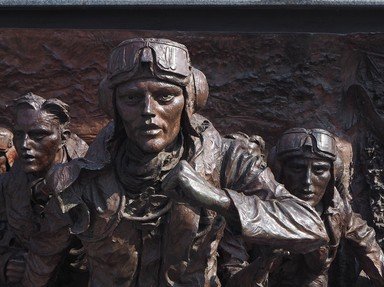Quiz Answer Key and Fun Facts
1. Limping home from Dunkirk, troops poured into the ports of Southern England. In France hastily improvised defences were being built up on the Somme and Aisne rivers with hope that the Maginot Line on the eastern line would hold out from German advances. However, in mid June German forces had crossed the River Marne, and moved south outflanking the Maginot Line. This chain of events saw Paris fall with no resistance and the French formally surrender. On what date was the French surrender?
2. The planned German aerial assault forces 2,820 aircraft. Of these, one third were fighter planes, whilst the rest were twin engined bombers, fighter bombers and single engined Stukas. The RAF (Royal Air Force) had 591 Spitfires, Hurricanes and two seater Defiants split into four groups. Number 10 group covered South-West England, Number 11 London and the South-East, Number 12 the Mildands and much of Wales and Number 13 the North and Scotland. Who was the Air Chief Marshal responsible for the running of these groups and RAF Fighter Command?
3. Hitler planned 'Sealion' to commence on September 15th, so on August 1st he ordered the Luftwaffe "to overcome the British air force with all means at its disposal, and as soon as possible". In as early as June many English coastal areas and convoys had been attacked, whilst a more intense bombardment during July of shipping in the Channel and hugely destructive attempt on coastal ports took place. Portsmouth was bombed on July 11th and on August 8th over 250 enemy aircraft sunk seven ships bound for Weymouth. However, these raids cost not only British sites and planes, but also signalled heavy loses for the Luftwaffe. Between July 10th and August 10th how many planes were lost by both sides combined?
4. The Luftwaffe were to begin the elimination of the RAF set for August 11th. After easily taking Poland and France, the German Commander-in-Chief promised Hitler of a swift and glorious success. It was said that within four days the south of England would be clear, and a four week timescale would be enough to defeat the whole force. Bombers would devastate ground installations, whilst the fighters would deal with the aerial threats. Which high-ranking Nazi made these claims?
5. The first day of the Battle of Britain (July 10th) saw nearly 1,500 Luftwaffe sorties with the loss of 46 planes. However, a small statistic at the time gave an indication that the RAF would ultimately succeed. Only 13 RAF planes were lost, a trend that hardly changed throughout the whole conflict. German claims however, showed a different scenario. They claimed on day one that 30 airfields had been destroyed and that 300 RAF planes had been lost. August 14th saw 500 Luftwaffe sorties and August 15th saw seven huge massed attacks. First, 40 JU-87 Stukas hit Kent, 65 Heinkel He 111s, with 35 Messerschmitt BF-110 fighter bombers as escort struck the north of England followed by 50 Junker JU-88s. However, each day the loss count was getting higher in the Luftwaffe coloumn. Over the two day period of August 15th and 16th what was the loss ratio for the Luftwaffe and the RAF?
6. August 18th saw the Luftwaffe take many heavy loses, 71 planes to 27 RAF. On the Germans' return to base it emerged that the Commander of the Luftwaffe had come to inspect the crew and the pilots, only to spend an hour or so insulting them. Doubts were expressed within the Luftwaffe about its strategy. The radar stations were becoming difficult to locate and with just one success at Ventnor it was time to think again. So what strategy change did the Luftwaffe make which would cost them many more planes?
7. The Germans knew the RAF was in trouble but had no idea how bad the situation was. They took a calculated gamble, hit the airfields of Number 11 Group in the south east. This in turn would force the RAF to expose what aircraft it had left. Between August 24th and September 6th the Luftwaffe mounted 33 huge raids, causing very heavy losses for the RAF. What was the approximate percentage of RAF pilots that were killed or injured in that period?
8. British defences had been warned on September 6th of invasion within the next three days, at this time attacks (the "blitz") on London had begun and forces were brought in to instant readiness. During the night of September 7-8th, London was subjected to by far the most severe attack, aimed partly at civilian targets.
The invasion however, never materialised but the Battle of Britain was far from over. The Luftwaffe begun flying deeper inland which allowed Number 12 group to intervene. On September 9th, 28 German planes were shot down to just 4 RAF planes. The Commander of the Luftwaffe was still confident of success, but two things kept getting in the way of German victory, the RAF being one but what other hurdle frustrated the Germans?
9. On August 20th Prime Minister Winston Churchill paid tribute to the RAF:
"Undaunted by the odds, unwearied in their constant challenge and mortal danger, they are turning the tide of world war by their prowess and devotion. Never in the field of human conflict was ---------------------------------------------" Complete the quote.
10. In the years before the war, pilots from Biggin Hill developed "jargon for the flyer", which to this day is still used within the RAF. What do these three jargon expressions actually mean: 1. Tally-ho, 2. Bogey, 3. Pancake?
Source: Author
doomed
This quiz was reviewed by FunTrivia editor
bloomsby before going online.
Any errors found in FunTrivia content are routinely corrected through our feedback system.

